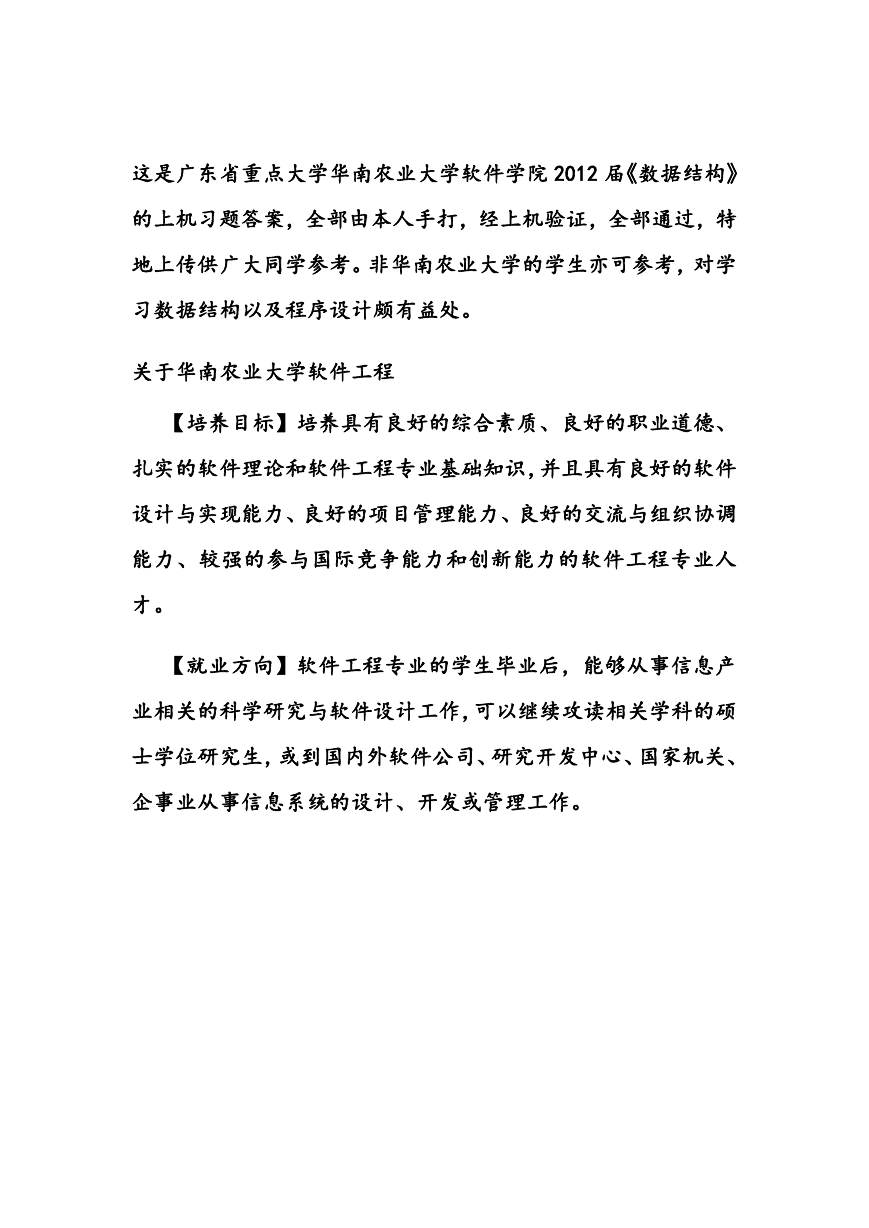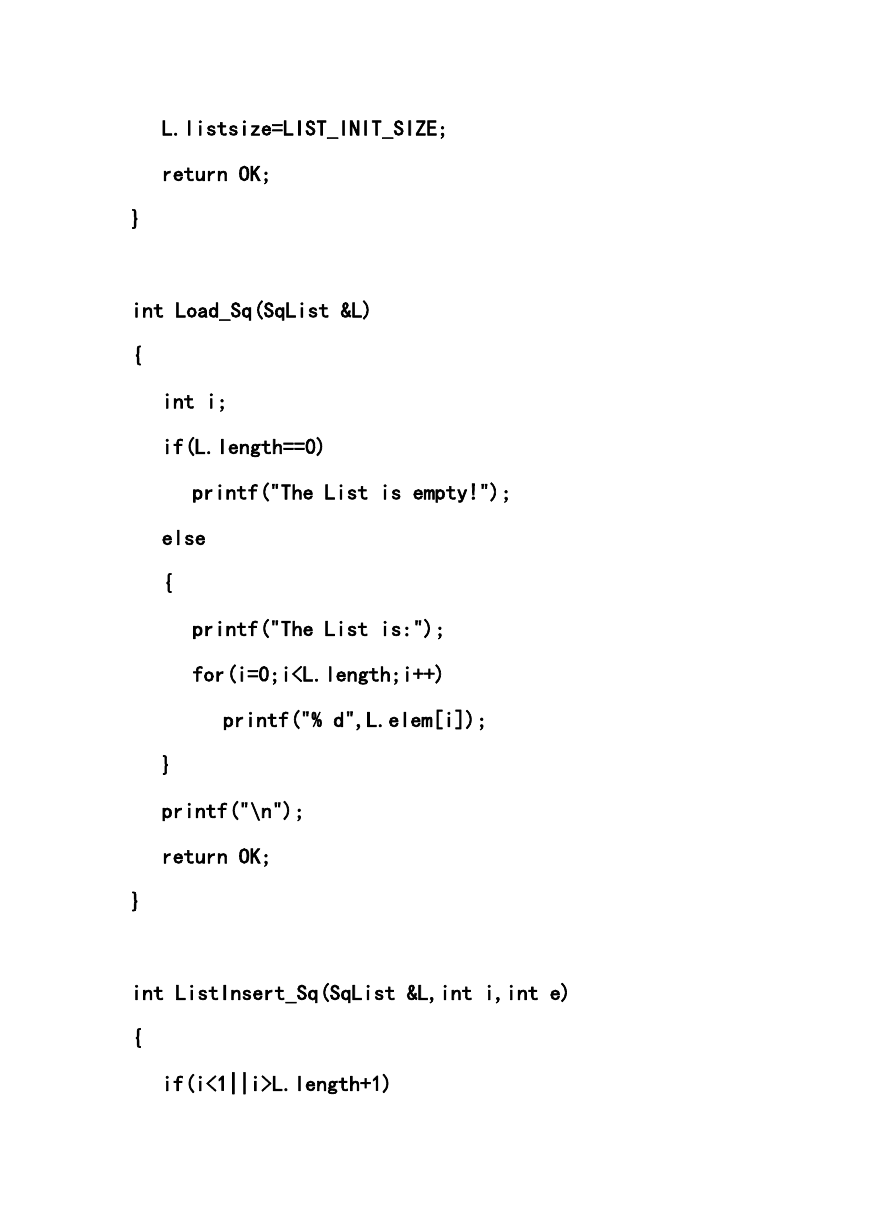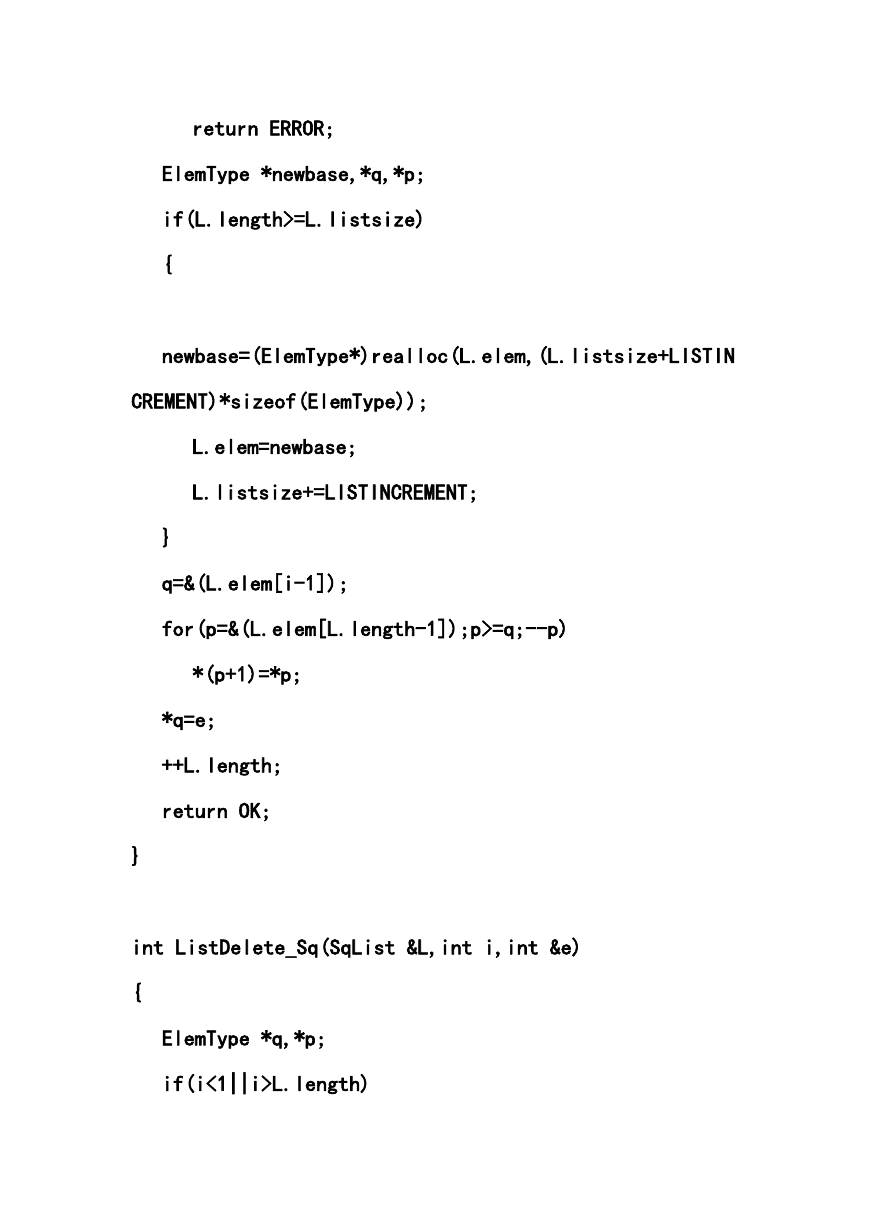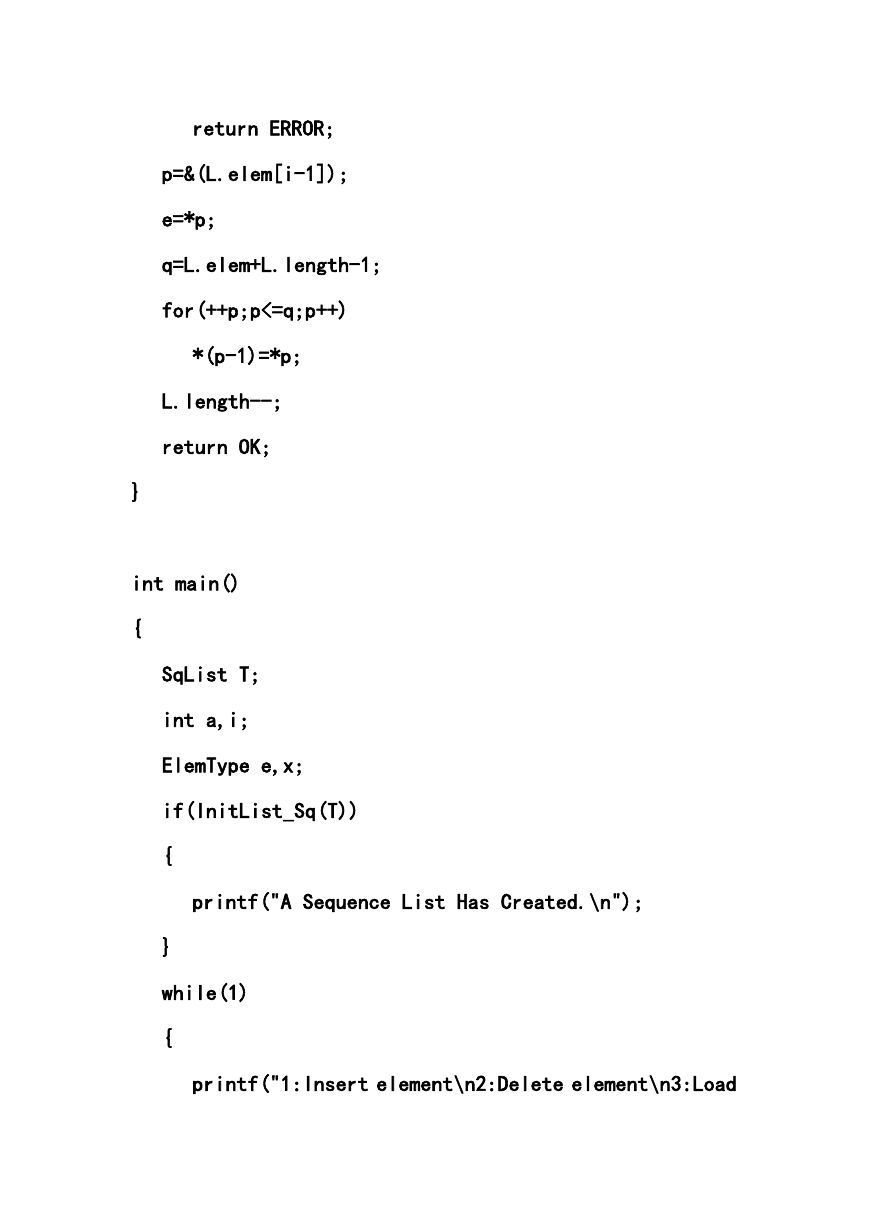这是广东省重点大学华南农业大学软件学院 2012 届《数据结构》
的上机习题答案,全部由本人手打,经上机验证,全部通过,特
地上传供广大同学参考。非华南农业大学的学生亦可参考,对学
习数据结构以及程序设计颇有益处。
关于华南农业大学软件工程
【培养目标】培养具有良好的综合素质、良好的职业道德、
扎实的软件理论和软件工程专业基础知识,并且具有良好的软件
设计与实现能力、良好的项目管理能力、良好的交流与组织协调
能力、较强的参与国际竞争能力和创新能力的软件工程专业人
才。
【就业方向】软件工程专业的学生毕业后,能够从事信息产
业相关的科学研究与软件设计工作,可以继续攻读相关学科的硕
士学位研究生,或到国内外软件公司、研究开发中心、国家机关、
企事业从事信息系统的设计、开发或管理工作。
�
2012 届华南农业大学
数据结构上机答案
1.1 顺序线性表的基本操作
#include
#include
#define OK 1
#define ERROR 0
#define LIST_INIT_SIZE 100
#define LISTINCREMENT 10
#define ElemType int
typedef struct
{
int *elem,length,listsize;
}SqList;
int InitList_Sq(SqList &L)
{
L.elem=(ElemType*)malloc(LIST_INIT_SIZE*sizeof(ElemT
ype));
L.length=0;
�
L.listsize=LIST_INIT_SIZE;
return OK;
}
int Load_Sq(SqList &L)
{
int i;
if(L.length==0)
printf("The List is empty!");
else
{
}
printf("The List is:");
for(i=0;iL.length+1)
�
return ERROR;
ElemType *newbase,*q,*p;
if(L.length>=L.listsize)
{
newbase=(ElemType*)realloc(L.elem,(L.listsize+LISTIN
CREMENT)*sizeof(ElemType));
L.elem=newbase;
L.listsize+=LISTINCREMENT;
}
q=&(L.elem[i-1]);
for(p=&(L.elem[L.length-1]);p>=q;--p)
*(p+1)=*p;
*q=e;
++L.length;
return OK;
}
int ListDelete_Sq(SqList &L,int i,int &e)
{
ElemType *q,*p;
if(i<1||i>L.length)
�
return ERROR;
p=&(L.elem[i-1]);
e=*p;
q=L.elem+L.length-1;
for(++p;p<=q;p++)
*(p-1)=*p;
L.length--;
return OK;
}
int main()
{
SqList T;
int a,i;
ElemType e,x;
if(InitList_Sq(T))
{
}
printf("A Sequence List Has Created.\n");
while(1)
{
printf("1:Insert element\n2:Delete element\n3:Load
�
all elements\n0:Exit\nPlease choose:\n");
scanf("%d",&a);
switch(a)
{
case 1: scanf("%d%d",&i,&x);
if(!ListInsert_Sq(T,i,x))
printf("Insert Error!\n");
else
printf("The
Element
%d
is
Successfully
Inserted!\n",x);
break;
case 2: scanf("%d",&i);
if(!ListDelete_Sq(T,i,e))
printf("Delete Error!\n");
else
printf("The
Element
%d
is
Successfully
Deleted!\n",e);
break;
case 3: Load_Sq(T);
break;
case 0: return 1;
}
�
}
}
1.2 合并顺序表
#include
#include
#define OK 1
#define ERROR 0
#define LIST_INIT_SIZE 100
#define LISTINCREMENT 10
#define ElemType int
typedef struct
{
int *elem,length,listsize;
}SqList;
int InitList_Sq(SqList &L)
{
L.elem=(ElemType*)malloc(LIST_INIT_SIZE*sizeof(ElemT
ype));
L.length=0;
L.listsize=LIST_INIT_SIZE;
�
return OK;
}
int Load_Sq(SqList &L)
{
}
int i;
for(i=0;i
















 2023年江西萍乡中考道德与法治真题及答案.doc
2023年江西萍乡中考道德与法治真题及答案.doc 2012年重庆南川中考生物真题及答案.doc
2012年重庆南川中考生物真题及答案.doc 2013年江西师范大学地理学综合及文艺理论基础考研真题.doc
2013年江西师范大学地理学综合及文艺理论基础考研真题.doc 2020年四川甘孜小升初语文真题及答案I卷.doc
2020年四川甘孜小升初语文真题及答案I卷.doc 2020年注册岩土工程师专业基础考试真题及答案.doc
2020年注册岩土工程师专业基础考试真题及答案.doc 2023-2024学年福建省厦门市九年级上学期数学月考试题及答案.doc
2023-2024学年福建省厦门市九年级上学期数学月考试题及答案.doc 2021-2022学年辽宁省沈阳市大东区九年级上学期语文期末试题及答案.doc
2021-2022学年辽宁省沈阳市大东区九年级上学期语文期末试题及答案.doc 2022-2023学年北京东城区初三第一学期物理期末试卷及答案.doc
2022-2023学年北京东城区初三第一学期物理期末试卷及答案.doc 2018上半年江西教师资格初中地理学科知识与教学能力真题及答案.doc
2018上半年江西教师资格初中地理学科知识与教学能力真题及答案.doc 2012年河北国家公务员申论考试真题及答案-省级.doc
2012年河北国家公务员申论考试真题及答案-省级.doc 2020-2021学年江苏省扬州市江都区邵樊片九年级上学期数学第一次质量检测试题及答案.doc
2020-2021学年江苏省扬州市江都区邵樊片九年级上学期数学第一次质量检测试题及答案.doc 2022下半年黑龙江教师资格证中学综合素质真题及答案.doc
2022下半年黑龙江教师资格证中学综合素质真题及答案.doc